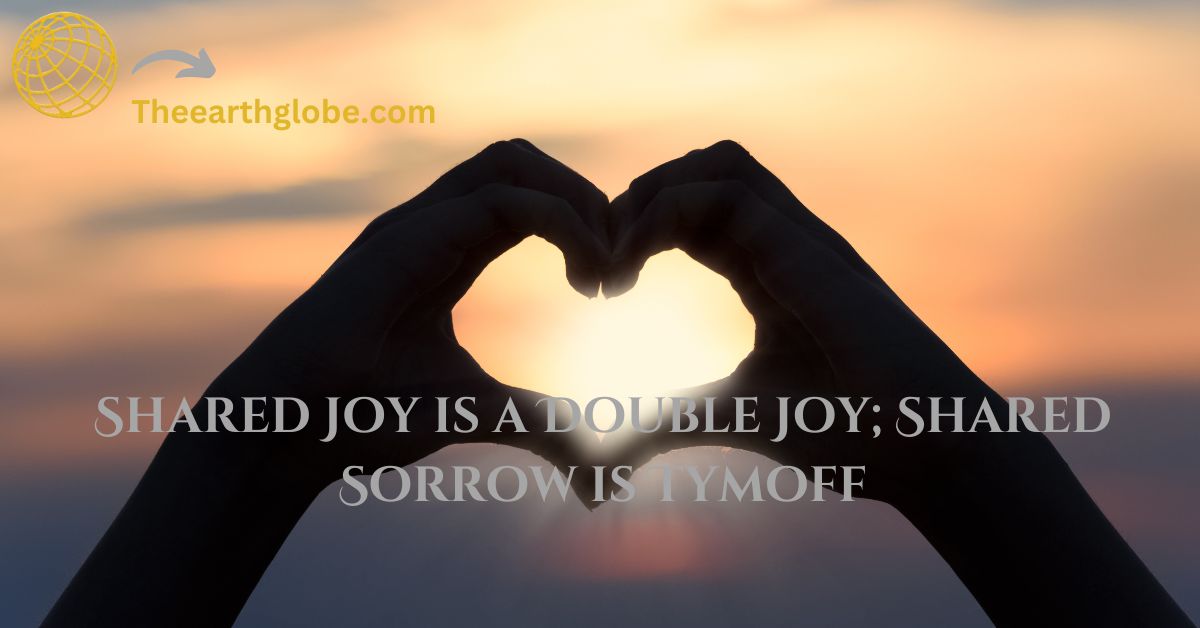Shared Joy is a Double Joy; Shared Sorrow is Tymoff
“Shared Joy is a Double Joy; Shared Sorrow is Tymoff” is a profound statement that highlights the importance of sharing our emotions with others. Whether it’s joy or sorrow, sharing our feelings can amplify the positive and alleviate the negative. This article explores the significance of this concept, delving into how sharing emotions impacts our mental and emotional well-being.

The Meaning Behind “Shared Joy is a Double Joy; Shared Sorrow is Tymoff”
The phrase “Shared Joy is a Double Joy; Shared Sorrow is Tymoff” emphasizes the power of shared experiences. When we share our happiness with others, it multiplies, creating a ripple effect of positivity. On the other hand, sharing our sorrow with someone who understands and empathizes can significantly lighten our emotional burden. This concept underscores the fundamental human need for connection and emotional support.
Post You Might Like: How i sleep at night knowing l’m failing all my cl – tymoff
The Power of Shared Joy
How Shared Joy Enhances Happiness
When we experience joy, sharing it with others enhances the feeling. Shared Joy is a Double Joy because it allows us to connect with others on a deeper level, reinforcing bonds and creating lasting memories. Whether it’s celebrating a personal achievement or a collective success, the act of sharing amplifies the joy.
Examples of Joy Amplified Through Sharing
Consider the joy of a family gathering, a group of friends celebrating a milestone, or a community coming together for a festival. These moments are heightened because they are shared. The collective energy and happiness in these situations make the joy more profound and memorable.
The Psychological Benefits of Celebrating Together
Sharing joy is not just about feeling good; it has psychological benefits too. It strengthens relationships, fosters a sense of belonging, and can even “improve our mental health by reducing stress” and increasing feelings of happiness and contentment.

Understanding Shared Sorrow
Why Sharing Sorrow Brings Relief
Just as sharing joy doubles it, sharing sorrow can halve it. Shared Sorrow is Tymoff because it helps us process our emotions and find comfort in knowing that we are not alone. When we share our pain with someone who cares, it can provide a sense of relief and support that eases our burden.
The Role of Empathy in Shared Sorrow
Empathy plays a crucial role in shared sorrow. When someone listens to our pain without judgment, it validates our feelings and helps us heal. This empathetic connection can be a powerful tool for emotional recovery, reminding us that we are understood and cared for.
Stories of Support: How Communities Help Each Other Heal
Communities often come together in times of sorrow, providing collective support that can be incredibly healing. Whether it’s through organized support groups, communal rituals, or simply being there for each other, these shared experiences help individuals cope with grief and loss more effectively.

Tymoff: A Modern Reflection on an Ancient Wisdom
What Tymoff Represents in Today’s Context
In today’s fast-paced world, the idea of Shared Joy is a Double Joy; Shared Sorrow is Tymoff remains as relevant as ever. Tymoff represents the timeless wisdom of emotional sharing, reminding us of the importance of staying connected with others in both good times and bad.
The Evolution of Emotional Sharing in the Digital Age
The digital age has transformed how we share our emotions. Social media platforms allow us to share joy and sorrow with a wider audience, often in real-time. While this can help us feel connected, it also highlights the importance of genuine, face-to-face interactions for deeper emotional support.
People Also Read: How to get meth out of your system faster
The Science Behind Shared Emotions
How Shared Joy and Sorrow Impact Mental Health
Research shows that sharing emotions can have a significant impact on mental health. Positive emotions like joy can boost our mood and reduce stress when shared, while expressing sorrow can prevent feelings of isolation and depression.
The Neuroscience of Emotional Connection
Neuroscientific studies have shown that sharing emotions activates certain areas of the brain associated with empathy, bonding, and social connection. This neurological response explains why sharing joy or sorrow can be so powerful.
Research on Social Support and Wellbeing
Social support is a key factor in overall well-being. Studies consistently show that individuals who have strong social networks and share their emotions are more resilient in the face of challenges and have better mental health outcomes.
Practical Ways to Share Joy and Sorrow
How to Build a Supportive Community
Building a supportive community is essential for sharing emotions effectively. This can involve nurturing existing relationships, joining groups with shared interests, or even creating new networks where you feel comfortable expressing your feelings.
Tips for Celebrating Together, Even When Apart
In our increasingly digital world, there are many ways to share joy and celebrate together, even when physically apart. Virtual gatherings, shared experiences through online platforms, and thoughtful gestures like sending a message or gift can help maintain emotional connections.
Techniques for Offering Support During Tough Times
When someone you care about is going through a difficult time, offering support can make a significant difference. Listening without judgment, being present, and providing practical help are all effective ways to share in their sorrow and help them cope.

The Cultural Significance of Sharing Emotions
Historical Perspectives on Shared Joy and Sorrow
Throughout history, sharing emotions has been a central part of human culture. From ancient rituals to modern celebrations, the act of coming together to share in joy or sorrow has always been a way to strengthen community bonds and provide mutual support.
How Different Cultures Emphasize Emotional Sharing
Different cultures have unique ways of expressing and sharing emotions. Some cultures emphasize communal celebrations, while others focus on private expressions of grief. Understanding these cultural differences can enrich our own approach to sharing joy and sorrow.
The Role of Rituals and Traditions in Amplifying Shared Emotions
Rituals and traditions play a crucial role in amplifying shared emotions. Whether it’s a wedding, a festival, or a funeral, these events bring people together and provide structured ways to express and share emotions, reinforcing the bonds between individuals and within communities.
Read To Know About: 27″ msi optix mag271r
Conclusion
In conclusion, Shared Joy is a Double Joy; Shared Sorrow is Tymoff serves as a powerful reminder of the importance of emotional sharing. Whether it’s the joy of a celebration or the sorrow of a loss, sharing these emotions with others enhances our human experience, strengthens our connections, and supports our mental and emotional well-being. In a world that often encourages isolation, embracing the wisdom of shared joy and sorrow can lead to a more fulfilling and connected life.
Frequently Asked Questions (FAQs)
What does “Shared Joy is a Double Joy” mean?
- It means that sharing your happiness with others amplifies the feeling, making the joy even greater.
How does sharing sorrow help?
- Sharing sorrow can lighten your emotional burden by providing comfort and support from others who empathize with your situation.
Why is sharing emotions important?
- Sharing emotions, whether joy or sorrow, strengthens connections with others and contributes to emotional well-being.
What role does empathy play in shared sorrow?
- Empathy allows others to understand and share in your sorrow, offering genuine support and easing the pain.
Can sharing joy really make you happier?
- Yes, sharing joy can increase your happiness by creating positive emotional connections and reinforcing bonds with others.
What is the significance of Tymoff in this context?
- Tymoff reflects the timeless wisdom that shared emotions, whether joyful or sorrowful, are crucial for human connection and well-being.
How can sharing joy and sorrow impact mental health?
- Sharing joy boosts happiness and reduces stress, while sharing sorrow can prevent feelings of isolation and depression.
What are some ways to share joy with others?
- You can share joy through celebrations, kind words, thoughtful gestures, or simply spending time together.
How does culture influence the sharing of emotions?
- Different cultures have unique traditions and practices for sharing emotions, which shape how people express and experience joy and sorrow.
Why is it said that “Shared Sorrow is Tymoff”?
- It suggests that sharing sorrow helps to divide and reduce the emotional pain, making it easier to cope with difficult times.






